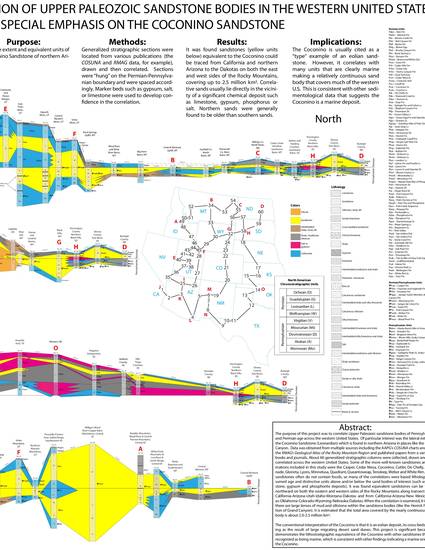
- Coconino Sandstone,
- Leonardian sandstones,
- Pennsylvanian sandstones,
- Permian sandstones
The purpose of this project was to correlate Upper Paleozoic sandstone bodies of Pennsylvanian and Permian age across the western United States. The lateral extent of the Coconino Sandstone (Leonardian) was of particular interest; it is found in northern Arizona in places like Grand Canyon. Data was obtained from multiple sources including the AAPG’s COSUNA charts and data, the RMAG’s Geological Atlas of the Rocky Mountain Region and published papers from a variety of books and journals. About 60 generalized stratigraphic columns were collected, drawn and then correlated across the western United States. Some of the more well-known sandstones and formations included in this study were the Casper, Cedar Mesa, Coconino, Cutler, De Chelly, Esplanade, Glorieta, Lyons, Minnelusa, Quadrant, Queantoweap, Tensleep, Weber and White Rim. These sandstones often do not contain fossils, so many of the correlations were based on lithology, presumed age and distinctive units above and/or below the sand bodies of interest (such as limestone, gypsum and phosphorite deposits). It was found equivalent sandstones can be traced northward on both the eastern and western sides of the Rocky Mountains along transects from California-Arizona-Utah-Idaho-Montana-Dakotas and from California-Arizona-New Mexico-Texas-Oklahoma-Colorado-Wyoming-Nebraska-Dakotas. When the correlation is examined, it is clear there are large lenses of mud and siltstone within the sandstone bodies (like the Hermit Formation of Grand Canyon). It is estimated that the total area covered by the nearly continuous sand body is about 2.0-2.5 million km2. The conventional interpretation of the Coconino is that it is an eolian deposit, its cross-beds forming as the result of large migrating desert sand dunes. This project is significant because it demonstrates the lithostratigraphic equivalence of the Coconino with other sandstones that are recognized as being marine, which is consistent with other findings indicating a marine origin for the Coconino.
Available at: http://works.bepress.com/john_whitmore/79/
